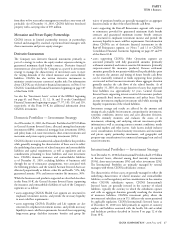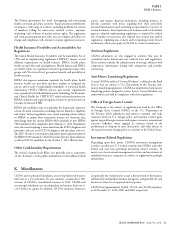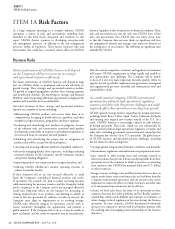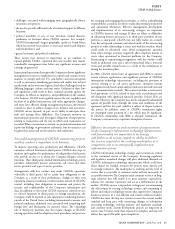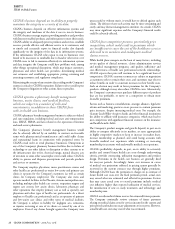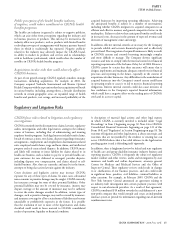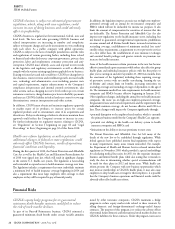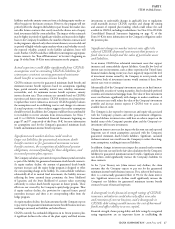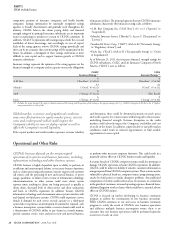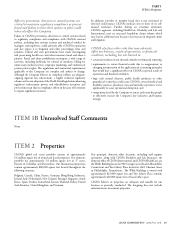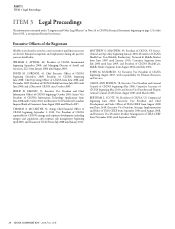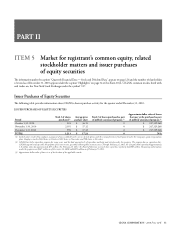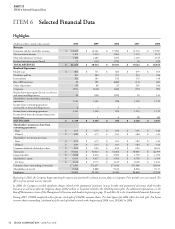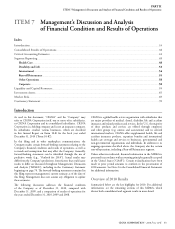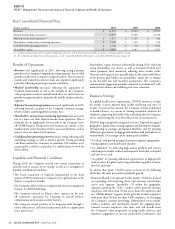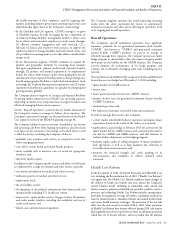Cigna 2010 Annual Report Download - page 47
Download and view the complete annual report
Please find page 47 of the 2010 Cigna annual report below. You can navigate through the pages in the report by either clicking on the pages listed below, or by using the keyword search tool below to find specific information within the annual report.CIGNA CORPORATION 2010 Form 10K 27
PARTI
ITEM 1A Risk Factors
liabilities under the annuity contracts from a declining equity market are
off set by gains on the futures contracts. However, the program will not
perfectly off set the change in the liability in part because the market does
not off er futures contracts that exactly match the diverse mix of equity
fund investments held by contractholders. e impact of this mismatch
may be higher in periods of signifi cant volatility and may result in higher
losses to the Company. In addition, the number of futures contracts used
in the program is adjusted only when certain tolerances are exceeded and
in periods of highly volatile equity markets when actual volatility exceeds
the expected volatility assumed in the liability calculation, losses will
result. Further, CIGNA could have diffi culty in entering into appropriate
futures contracts. See “Run-off Reinsurance” in Section G beginning on
page 14 of this Form 10-K for more information on the program.
Actual experience could diff er signifi cantly from CIGNA’s
assumptions used in estimating CIGNA’s liabilities for
reinsurance contracts covering guaranteed minimum
death benefi ts or minimum income benefi ts.
CIGNA estimates reserves for guaranteed minimum death benefi t and
minimum income benefi t exposures based on assumptions regarding
lapse, partial surrender, mortality, interest rates, volatility, reinsurance
recoverables, and, for minimum income benefi t exposures, annuity
income election rates. ese estimates are currently based on CIGNA’s
experience and future expectations. CIGNA monitors actual experience
to update these reserve estimates as necessary. CIGNA regularly evaluates
the assumptions used in establishing reserves and changes its estimates
if actual experience or other evidence suggests that earlier assumptions
should be revised. In addition, the Company could have losses attributable
to its inability to recover amounts from retrocessionaires. See Notes 7
and 11 to CIGNA’s Consolidated Financial Statements beginning on
pages 87 and 97, respectively of this Form 10-K, for more information
on assumptions used for the Company’s guaranteed minimum death
benefi t and minimum income benefi t exposures.
Signifi cant stock market declines could result in
larger net liabilities for guaranteed minimum death
benefi t contracts or for guaranteed minimum income
benefi t contracts, the recognition of additional pension
obligations, increased funding for those obligations, and
increased pension plan expenses.
e Company calculates a provision for expected future partial surrenders
as part of the liability for guaranteed minimum death benefi t contracts.
As equity markets decline, the amount of guaranteed death benefi t
exposure increases and the equity hedge program is designed to off set
the corresponding change in the liability. If a contractholder withdraws
substantially all of its mutual fund investments, the liability increases
refl ecting the lower assumed future premiums, the lower likelihood
of lapsation, and the lower likelihood of account values recovering
suffi ciently to reduce death benefi t exposure in future periods. ese
eff ects are not covered by the Company’s equity hedge program. us
if equity markets decline, the provision for expected future partial
surrenders increases and there is no corresponding off set from the
hedge program.
As equity markets decline, the claim amounts that the Company expects
to pay out for the guaranteed minimum income benefi t business increases
resulting in increased net liabilities and related losses.
CIGNA currently has unfunded obligations in its frozen pension plan.
A signifi cant decline in the value of the plan’s equity and fi xed income
investments or unfavorable changes in applicable laws or regulations
could materially increase CIGNA’s expenses and change the timing
and amount of required plan funding, which could reduce the cash
available to CIGNA, including its subsidiaries. See Note 10 to CIGNA’s
Consolidated Financial Statements beginning on page 92 of this
Form 10-K for more information on the Company’s obligations under
the pension plan.
Signifi cant changes in market interest rates aff ect the
value of CIGNA’s fi nancial instruments that promise a
fi xed return or benefi t and the value of particular assets
and liabilities.
As an insurer, CIGNA has substantial investment assets that support
insurance and contractholder deposit liabilities. Generally low levels of
interest rates on investments, such as those experienced in United States
fi nancial markets during recent years, have negatively impacted the level
of investment income earned by the Company in recent periods, and
such lower levels of investment income would continue if these lower
interest rates were to continue.
Substantially all of the Company’s investment assets are in fi xed interest-
yielding debt securities of varying maturities, fi xed redeemable preferred
securities and commercial mortgage loans. e value of these investment
assets can fl uctuate signifi cantly with changes in market conditions. A
rise in interest rates could reduce the value of the Company’s investment
portfolio and increase interest expense if CIGNA were to access its
available lines of credit.
e Company is also exposed to interest rate and equity risk associated
with the Company’s pension and other post-retirement obligations.
Sustained declines in interest rates could have an adverse impact on the
funded status of the Company’s pension plans and the Company’s re-
investment yield on new investments.
Changes in interest rates may also impact the discount rate and expected
long-term rate of return assumptions associated with the Company’s
guaranteed minimum death benefi t liabilities. Signifi cant, sustained
declines in interest rates could cause the Company to reduce these long-
term assumptions, resulting in increased liabilities.
In addition, changes in interest rates impact the assumed market returns
and the discount rate used in the fair value calculations for the Company’s
liabilities for guaranteed minimum income benefi ts. Signifi cant interest
rate declines could signifi cantly increase the Company’s liabilities for
these contracts.
As the 7-year Treasury rate (claim interest rate) declines, the claim
amounts that the Company expects to pay out for the guaranteed
minimum income benefi t business increases. For a subset of the business,
there is a contractually guaranteed fl oor of 3% for the claim interest
rate. Signifi cant interest rate declines could signifi cantly increase the
Company’s net liabilities for guaranteed minimum income benefi t
contracts because of increased exposures.
A downgrade in the fi nancial strength ratings of CIGNA’s
insurance subsidiaries could adversely aff ect new sales
and retention of current business, and a downgrade in
CIGNA’s debt ratings would increase the cost of borrowed
funds and aff ect ability to access capital.
Financial strength, claims paying ability and debt ratings by recognized
rating organizations are an important factor in establishing the


